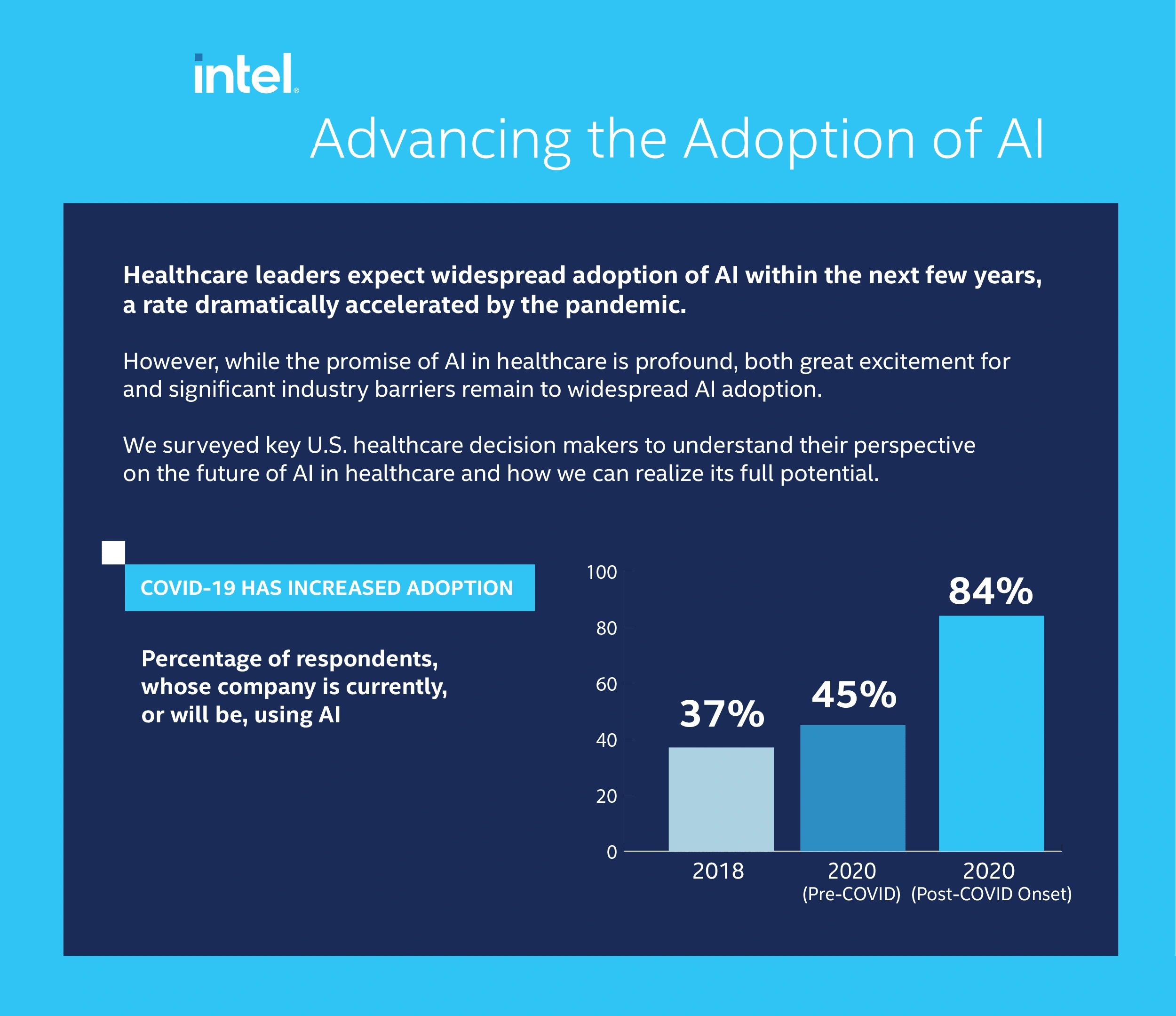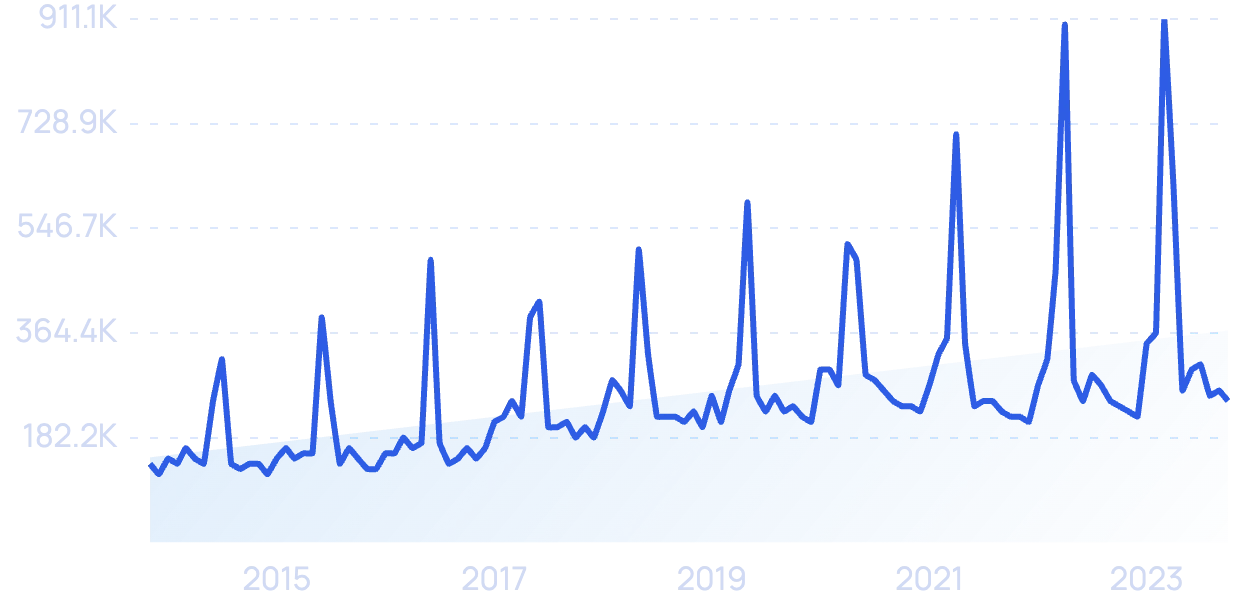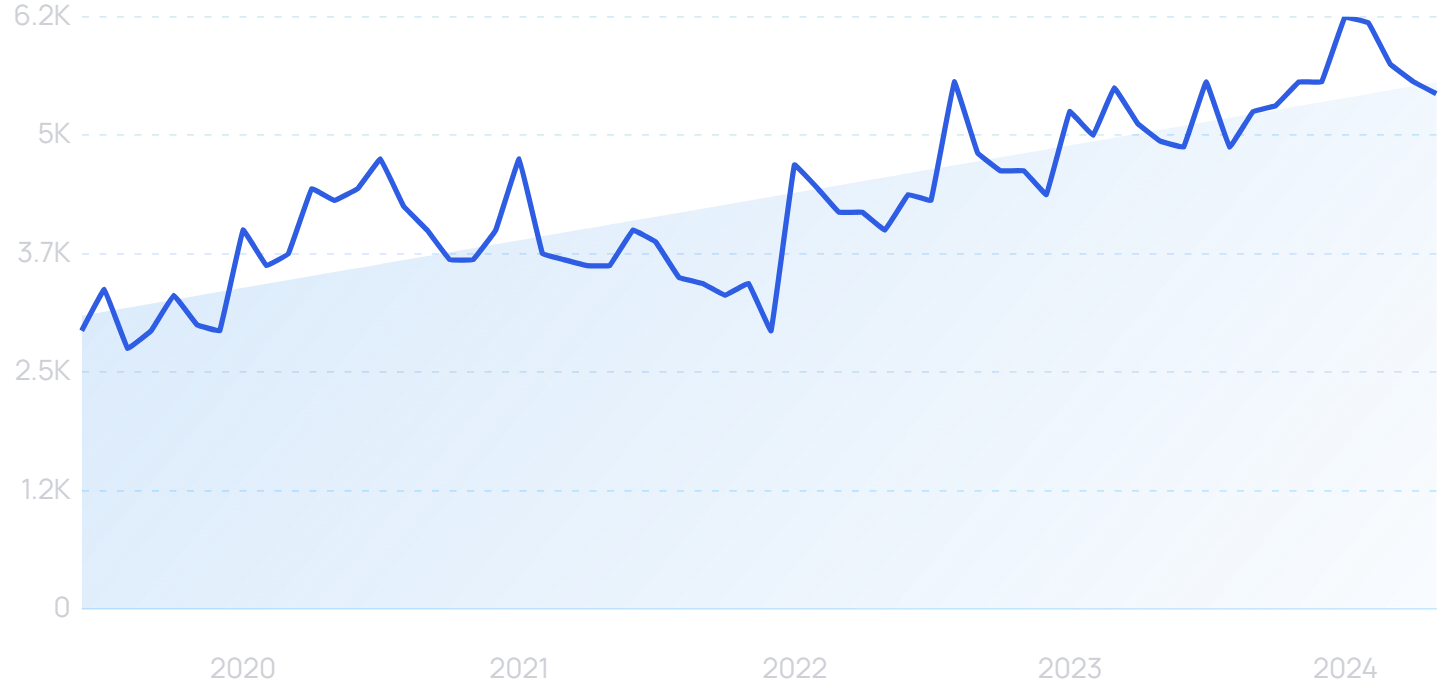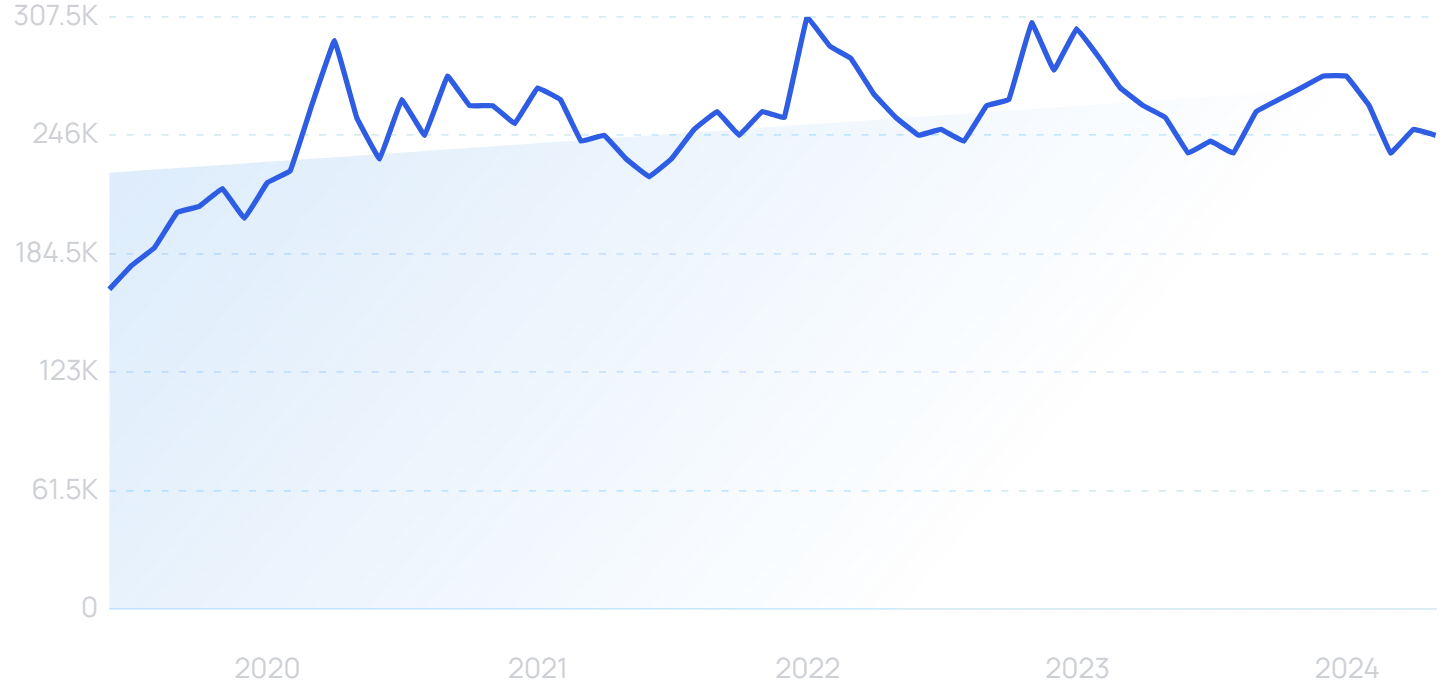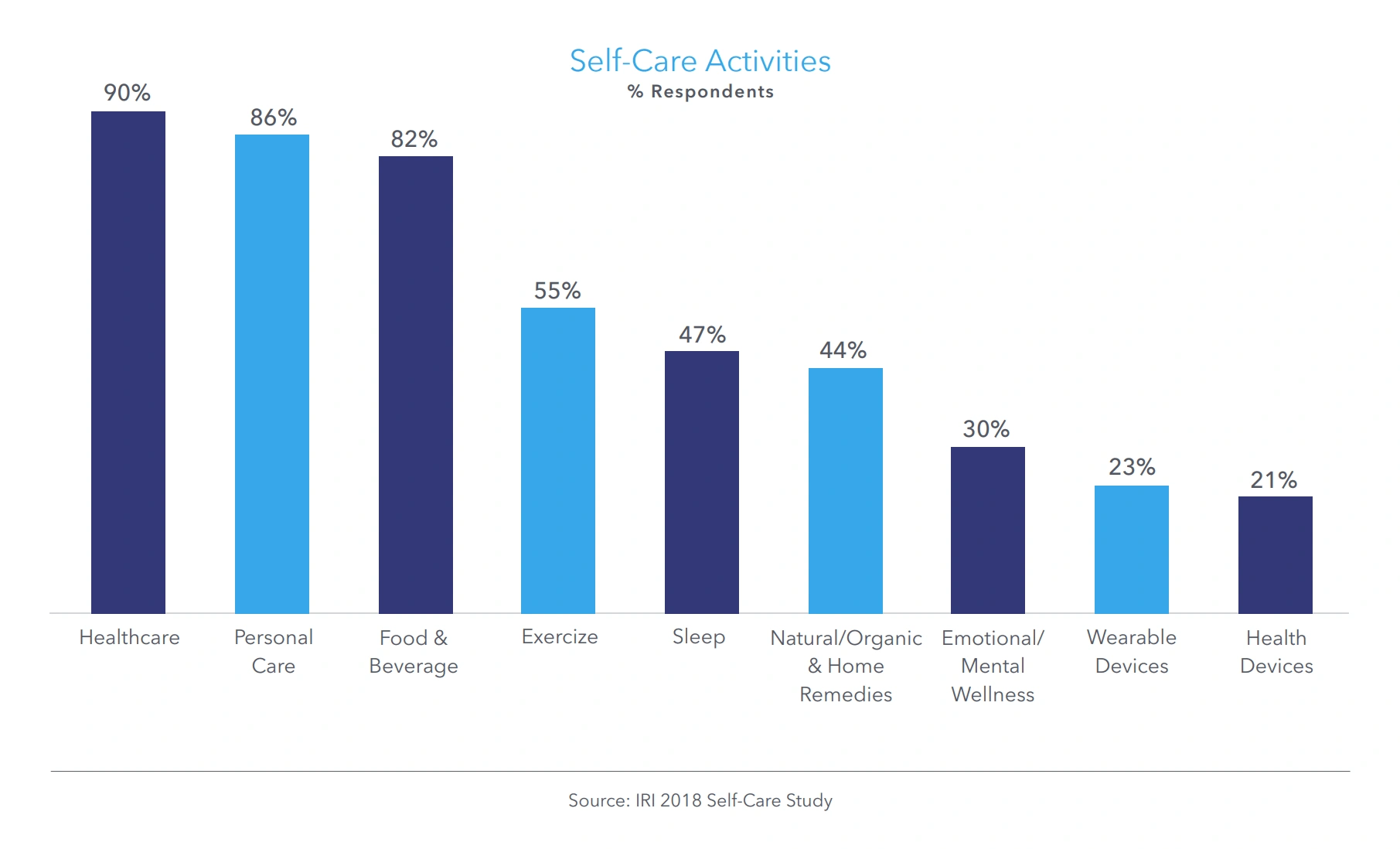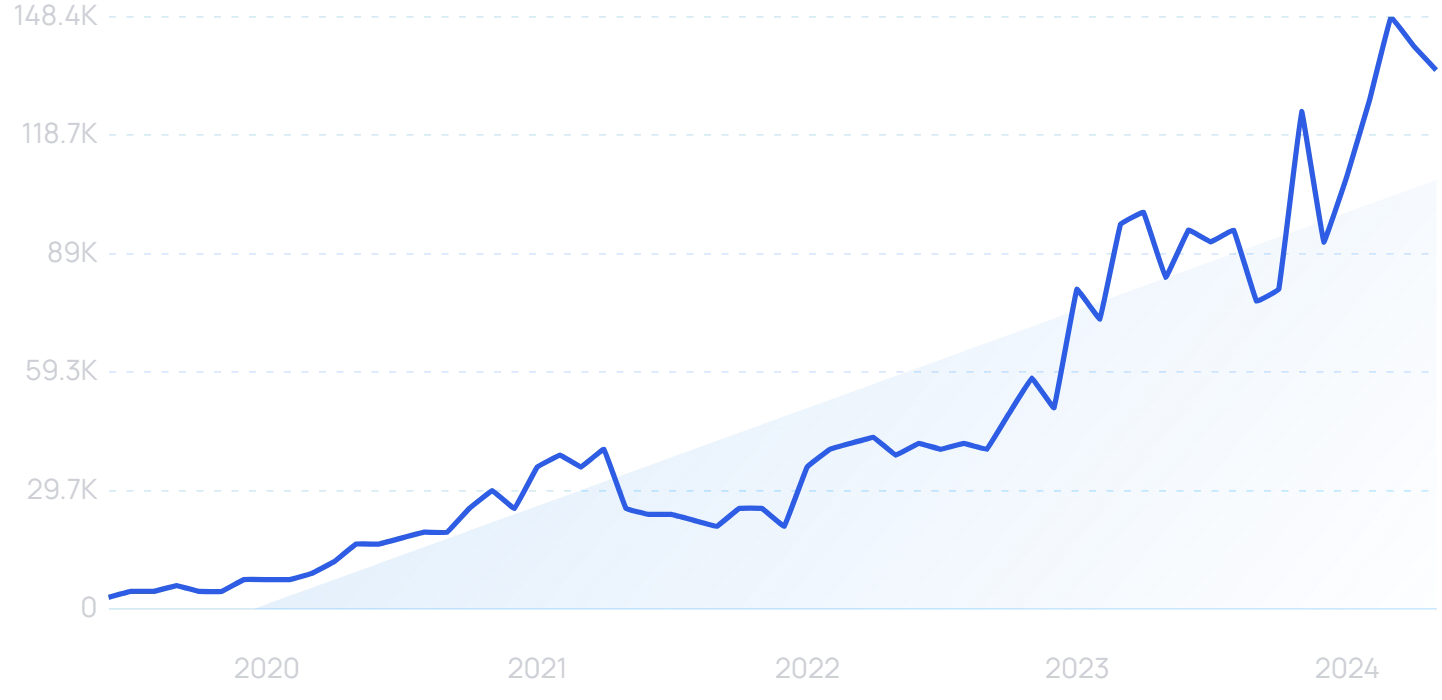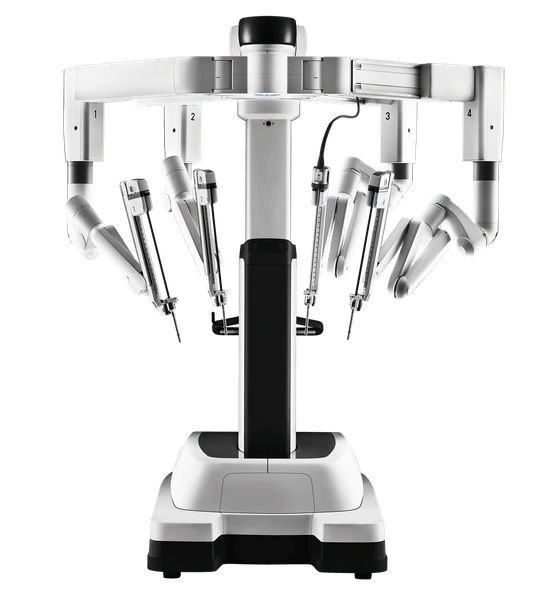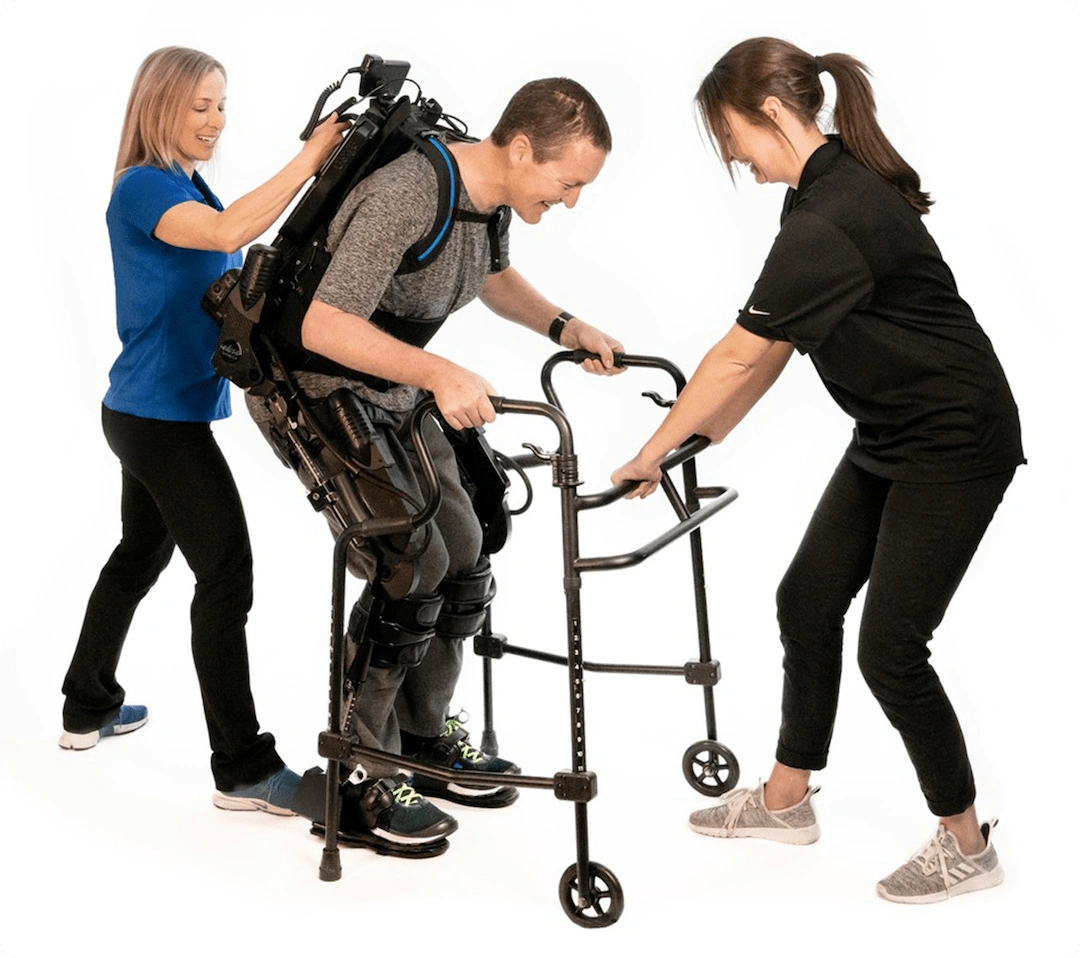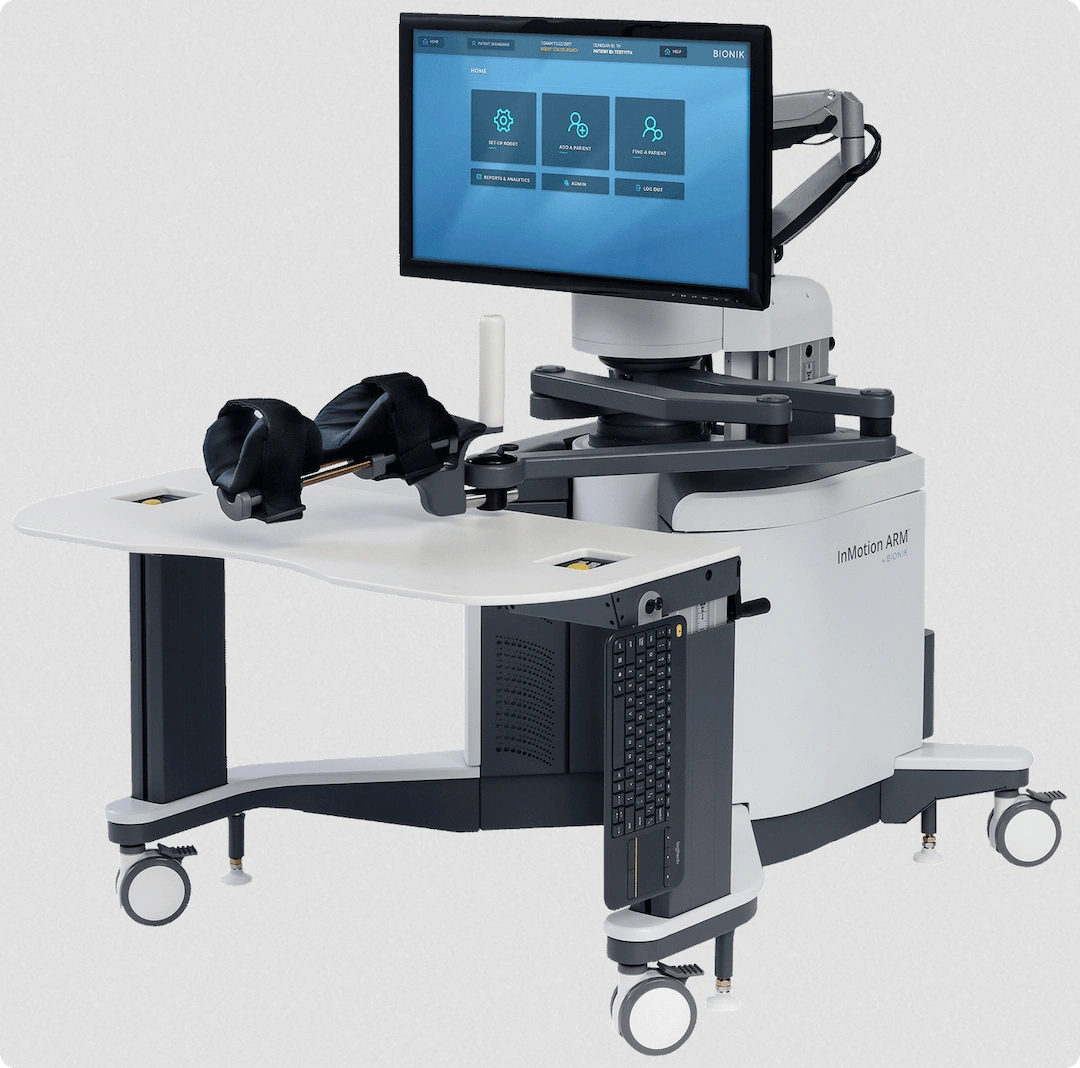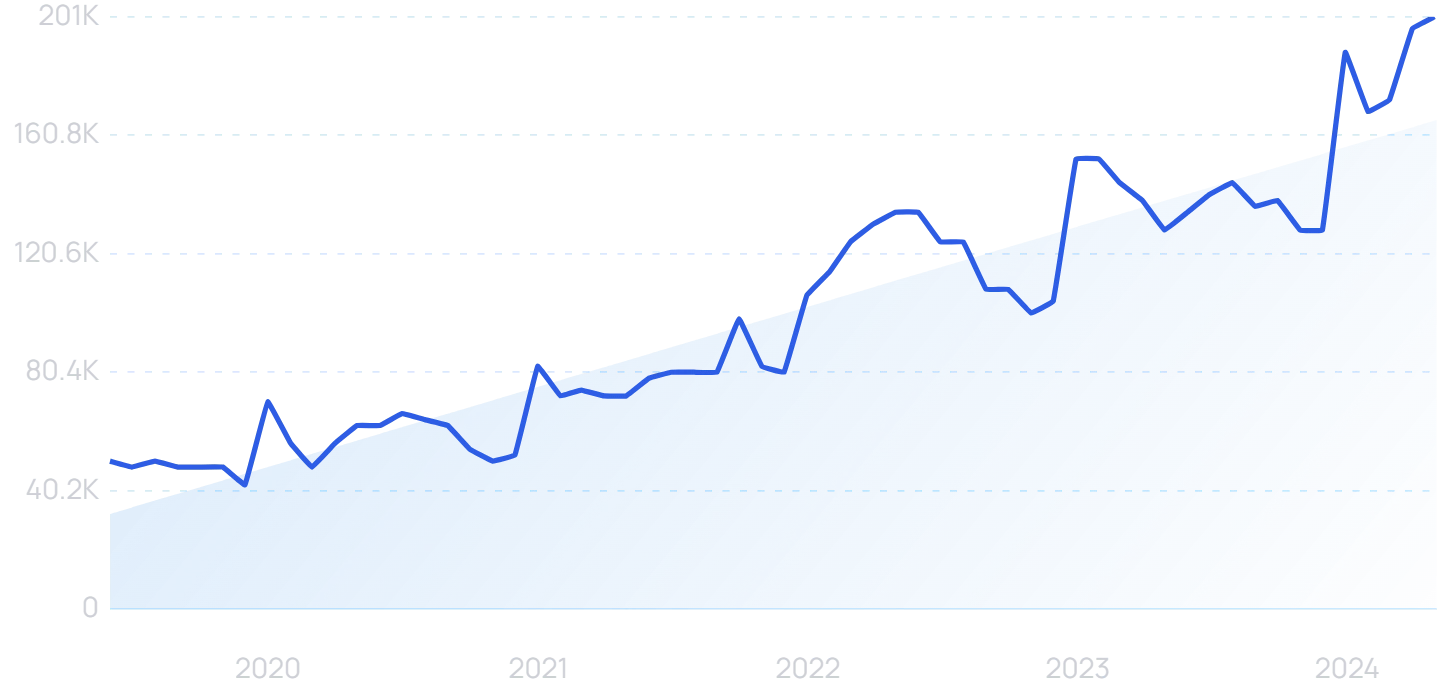
Top 7 Health & Wellness Trends (2024)
You may also like:
In this report we’ll cover:
- Why millennials are opting for “self-care”
- New technology being used in the healthcare world
- Why fasting remains popular
- Lots more
With that, is a list of emerging health trends happening right now (in 2024).
1. Healthcare begin to rely on AI
The adoption of artificial intelligence (AI) is everywhere in our world today, including the healthcare sector.
"Healthcare AI" has exploded in the last 5 years, with a search growth of 456%.
For many years, AI’s presence in healthcare has been a topic that’s discussed but not implemented.
For example, nearly half of hospitals say they have an AI strategy, but only 29% of hospitals report having implemented the strategy.
But in the coming years, we will likely see the capabilities of AI in the healthcare sector come to fruition.
According to an Intel report, the pandemic has rapidly accelerated the adoption of AI in the healthcare field.
When surveyed pre-COVID, 45% of respondents said their healthcare organization was currently using or will be using AI.
Post-COVID, that number jumped to 84%.
Interest in AI among healthcare executives has risen over the past three years, with the biggest jump being seen post-pandemic.
AI is even being used in direct patient care.
One example: New York’s Northwell Health is using AI in its transitions of the care management program.
They report that patients who received treatment based on AI recommendations had 23.6% fewer readmissions than similar patients who didn’t receive AI treatment recommendations.
Northwell Health values these cost savings at more than $11k per patient.
AI is also being used for the early detection of health issues.
Nines is an AI-driven company that helps radiologists diagnose illnesses quickly.
Their NinesAI software can alert radiologists to a life-threatening diagnosis within 15 seconds after the scan.
Komodo Health is another example of a healthcare AI startup.
The company is putting together an AI-driven “healthcare map” that tracks nearly 325 million de-identified patients throughout their healthcare journey.
With all of the data and analytics they’ve amassed, they are selling tools to those who need market intelligence in the healthcare industry.
A recent funding round brought in $200 million and the company is now valued at $3.3 billion.
Stay on top of the latest health startups
We're always bringing out new blog posts, and updating our existing ones. But did you know that we also have tools that allow you to access our live data?
For instance, you can check out the fastest-growing health startups right now. In fact, you can track high-growth companies in more than 20 industries.
And we have an even more granular industry breakdown of the most-visited websites. Not only can you see the top healthcare sites via our analytics tools, you can also see the most popular websites for wellness, medical devices and equipment, and 50+ other categories.
2. Fasting goes mainstream
According to a recent poll fasting is the #1 most popular dieting approach in America.
According to a study, fasting is a more popular dieting approach than keto and low-carb.
Intermittent fasting is the practice of avoiding all food and beverages except water, coffee, and unsweetened tea for an extended period of time.
In practice, it’s used in two different ways:
The first is every day, typically for the majority of the day.
For example, “16:8” intermittent fasting consists of an 8-hour eating window during the day, followed by a 16-hour fasting window overnight and into the next day.
This is also called “time-restricted eating”.
It’s been shown to help with fat loss, enhance aerobic capacity, and reduce the risk of diabetes.
The other way intermittent fasting is used is by occasionally avoiding all foods for a full 24-hour period or longer.
(Sometimes this is simply called “fasting”.)
Searches for "fasting" spike every holiday season. But are still seeing generally strong long-term growth (80% over 10 years).
Studies show that longer fasting periods like these can protect heart function, reduce the risk or symptoms of diseases like Alzheimer’s, and perhaps even improve lifespan.
While an impressive 87% of those who have tried intermittent fasting to lose weight say it was effective for that purpose.
Intermittent fasting is clearly a popular (and apparently effective) diet.
So it’s no surprise that a variety of products and companies have emerged to help people stick with it.
For example:
Mobile apps like Zero and LIFE offer fasting timers and tips. As well as integration with social apps and fitness trackers.
As the most popular fasting app, Zero alone has now logged over 2 billion fasted hours.
Founded by entrepreneur and investor Kevin Rose, the company raised an $8 million Series A round led by Greycroft in 2020.
And both Zero and LIFE also offer premium memberships with additional features like personalized coaching. (Zero’s costs $69.99 per year, while LIFE’s costs $2.99 per month.)
Searches for “Zero app” have increased by 85% over 5 years.
Fasting tea is another growing fasting-related product category.
Just about any plain tea can be used for fasting purposes, like green tea, black tea, hibiscus, ginger, and more.
These teas can help make fasting easier than drinking water alone.
And it’s thought that caffeinated teas may help increase the effectiveness of the fast.
There are also specialized teas like the crystallized Pique Tea.
Pique creates its concentrated teas through a “cold-brew crystallization” process, resulting in a form of tea that dissolves in hot or cold water.
Zero Tea is another brand that’s geared toward fasting purposes.
Intermittent fasting kits are another product type in this space.
Some people consider temporary periods of caloric restriction to be intermittent fasting as well.
So intermittent fasting kits can include a variety of supplements and/or foods, to be portioned out over a series of days.
There are also a variety of diets related to intermittent fasting. Including the fasting-mimicking diet, the Longevity Diet, the Warrior Diet, alternate-day fasting, and OMAD.
And the fasting meta trend goes beyond food.
Non-dietary fasts include:
- Skin fasts — avoiding skincare products for a period of days or weeks, which some dermatologists say allows the skin to return to its natural balance.
- Dopamine fasts — a fast from excitement, in order for people to let themselves feel bored and reset their ability to focus.
- Screen fasts, social media fasts and media fasts — similar to a dopamine fast, these fasts are intended to give yourself a break from exciting or anxiety-producing stimulation.
3. Gen Z prioritizes self-care
Self-care is an extremely popular spending category among Gen Z and millennials, who spend more than twice as much on it as Baby Boomers do.
Google search growth for "self-care" have increased steadily since 2020.
As part of the multi-trillion-dollar global wellness industry, 9 out of 10 Americans practice some kind of self-care.
And a third of them have increased their self-care activities recently.
Americans are investing more time and money into self-care than ever before.
This trend includes habits, products and services that help achieve the overall goal of well-being (both mental and physical).
For example, meditation apps have been on a tear recently.
Calm (the startup behind the popular Calm meditation app) was valued at $1 billion in early 2024. (Up from $250M in 2018.)
Other growing major meditation apps include Headspace, Waking Up, Breethe, Insight Timer, and Ten Percent Happier.
Skincare is another product category that’s been booming as part of the self-care movement.
Sales in skincare have been rising by about 5% per year since 2014.
Skincare incumbents like L'Oreal's CeraVe have been taking full advantage of this wave.
But so have newer brands like Goop, Acaderma, and DRMTLGY.
Searches for skincare startup DRMTLGY have exploded recently, rising 4,450% over 5 years.
When it comes to self-care purchases, consumers are reportedly very open to experimenting with new brands, services and product types.
Leaving a big opening for skincare startups to make a dent.
That openness to new products also explains how CBD products, which were not legalized nationwide in the US until 2018, are now used by 28% of US consumers.
Industry studies show that almost a third of all Americans use CBD.
As a category, CBD products were expected to reach $20 billion in sales by 2024. And in May 2025, CBDFX received more than 145,000 visits.
People are placing more importance on sleep now, too.
(35.3% of adults get less sleep than they should, and loss of sleep has been linked to health problems like depression, obesity, and diabetes.)
At home, the priority is sleep hygiene: optimizing your habits and bedroom for better sleep.
Trackers like the Oura Ring are helping people understand their sleep cycles and improve their habits.
Another way people are getting better sleep is with apps like SleepTown.
SleepTown is a habit-tracking and coaching app with one goal: to help you sleep more.
The SleepTown app.
The same app developer that made SleepTown is also behind Forest.
This app helps with productivity as well as work-life balance (another component of self-care).
Specifically, SleepTown uses gamification to help people spend less time on their smartphones.
It effectively locks your phone with a slow animation of a growing tree. If you interrupt its growth by using the phone for something else before the timer runs out, the tree dies.
4. Rise of medial robots
The global medical robotics market is forecast to reach $24.23 billion by 2028, up from $11.47 billion in 2023.
Robotic-assisted surgical equipment makes up most of the market currently, with industry leader Intuitive Surgical earning over $4 billion per year alone.
Intuitive Surgical makes Da Vinci surgical robots.
The Da Vinci isn’t autonomous: it’s a tool that surgeons operate.
But it helps them make more precise incisions and sutures, thanks to features like its “adaptive motion scaling”.
(The system also allows for telesurgery — where, for example, a surgeon in New York can operate on a patient in California. But this practice is still in very early stages and not widely done.)
The Intuitive Surgical Da Vinci.
Intuitive also sells a robotic-assisted platform for minimally invasive lung biopsies. As of November 2023, the company has a market cap of $98.1 billion.
Competitors include Stryker ($104.9 billion market cap) and Medtronic ($96.5 billion), both of which also sell non-robotic medical devices.
Only about 2% of global surgeries use robotic assistance, which leaves huge room for growth.
However, the surgical segment isn’t expected to be the fastest-growing portion of medical robotics.
Rehabilitation robots also have potential for future growth.
The rehabilitation robotics category is forecast to grow from $530 million in 2018 to $2.6 billion in 2026.
One rehabilitation robot is the EksoNR by Ekso Bionics.
The EksoNR is an exoskeleton that lets patients with brain injuries stand and walk during their rehabilitation.
The EksoNR by Ekso Bionics.
Ekso Bionics also produces the EksoUE, for upper-body mobility.
Other rehabilitation robotics include:
The Armeo Power by Hocoma. This Switzerland-based company boasts that 9 of the 10 best US rehabilitation hospitals use their solutions.
A whole range of bionics from Cyberdyne, including for the legs, the lower back, and the elbow.
The ReWalk Exoskeleton and ReStore Exo-Suit are also available for personal use.
(The ReWalk Exoskeleton was the first exoskeleton to get FDA clearance for personal and rehabilitation use.)
And the InMotion ARM by Bionik is a type of robotic device known as an “end-effector” system.
Unlike an exoskeleton, the base of the InMotion ARM system stays in one place while part of it is used by the patient.
The InMotion ARM - a fixed robotic rehabilitation device.
It’s still early days for rehabilitation robots, but studies have shown that their use can strongly improve motor recovery in injured patients.
Exoskeletons are also being tested as a way to give mobility to paralyzed people who are beyond rehabilitation.
As a whole, the exoskeleton robotics market hit an estimated $2.8 billion in value in 2023.
(Though part of that growth was fueled by military and industrial applications.)
Here are some other examples of robotics in healthcare:
XENEX disinfection robots. In the US, about as many people die from healthcare-associated infections as from AIDS, breast cancer, and car accidents combined. XENEX robots use UV light to disinfect hospital rooms and surgery wards, reducing infection rates by 50-100%.
Cell-sized Nanorobots are being developed at the University of California San Diego to kill antibiotic-resistant bacteria.
Robotic prosthetics: bionic arms and legs with receptors that allow patients to “feel” as if they were their natural limbs. These aren’t yet in widespread use, but three Swedish patients have been living with such prostheses for years.
Moxi, a friendly robotic hospital assistant. It brings supplies to patients’ rooms, delivers lab samples, transports soiled linens, and more.
The Medineering endoscopic robot can move and hold an endoscope (tiny camera) inside a patient’s body with more precision than human hands can.
Small “capsule robots” are being developed by Vanderbilt University for colonoscopies, biopsies, and polyp removal.
The world’s first implantable bionic human eye was developed by Australia’s Monash University and successfully trialed in sheep in July.
Autonomous robots may be able to conduct surgery (or parts of it) on their own in human patients within a few years.
One was already able to outperform human surgeons in a controlled testing environment in 2016.
5. Increased focus on mental health
Mental health is a topic that was beginning to emerge from the shadows before the pandemic.
Now, post-pandemic, the topic has been moved to the forefront of conversations in homes, schools, and workplaces.
The State of Mental Health in America Report showed that 19% of Americans are living with a mental health condition.
That’s more than 47 million people - 1.5 million more than in 2020.
The Kaiser Family Foundation reports that more than 30% of adults in the US currently report symptoms of anxiety or depression.
That’s an increase of 29% compared to pre-pandemic levels.
The states with the highest percentage of adults with symptoms of anxiety or depression are Arkansas, Kentucky, and Louisiana.
There's also increased mental health concerns when it comes to children and teenagers.
According to the NIH, 40% more children are experiencing mental health issues compared to a decade before.
Some teens are advocating for “mental health days” in order to be able to take a day off from the stress of school.
Students in Maryland went so far as to work with local officials to introduce legislation regarding mental health days in the Maryland General Assembly.
Investors are tapping into the increased emphasis on mental health.
Reinsurance Group of America reports that investors put more than $1 billion into mental health and wellness startups through the third quarter of 2020.
One of those startups is Brightline, a mental health platform for kids and teens.
The company raised $72 million in a Series B funding round, bringing its total funding to over $100 million.
Lyra Health is another start-up that’s had great success since launching in 2015.
The search term “Lyra Health” has seen 320% growth in the last 5 years.
The company is aimed at helping employers provide mental health services to their employees.
Lyra Health raised $200 million in new funding and is currently valued at $5.58 billion.
The number of mental health apps is on the rise, too.
One expert said the total number is between 10k and 20k apps.
The meditation app Headspace is one of the most successful mental health apps.
It’s been downloaded more than 70 million times.
The brand recently launched two series focused on peaceful sleep and meditation on Netflix and a podcast channel with Apple podcasts.
The $320-million company has partnered with big-name brands like Microsoft, Sesame Street, and Solera Health.
6. Probiotics and prebiotics go mainstream
“Gut health” has been a popular buzzword for the past few years.
This trend is driven, in part, by the fact that gastrointestinal symptoms are extremely prevalent in the United States.
One study found that more than 60% of people have at least one uncomfortable GI symptom per week.
Interest in "gut health" has surged 305% over the last 5 years.
Scientific research has discovered that a healthy gut microbiome prevents disease, improves the immune system, and even regulates brain behavior.
Humans need a certain level of good bacteria in their gut in order for it to function properly.
There are two types of widely available supplements that are sold with the goal of increasing this good bacteria: probiotics and prebiotics.
Probiotics, living strains of bacteria that boost the population of good bacteria in the gut, are one of the top-selling gut health supplements in the United States.
Experts suggest the probiotic market could reach $85 billion by 2027.
The closely related prebiotic market is growing even faster.
Prebiotics are plant fibers that act as food for good gut bacteria.
The prebiotic market is forecast to grow by approximately 20% over the next two years.
The gut health trend isn’t just limited to humans. Companies are now marketing gut health products to pet owners too.
Animal Biome will analyze a stool sample from a cat or dog to determine the pet’s gut imbalances.
Based on the results, the company will recommend one of their pet supplements.
So far, Animal Biome has raised over $12 million in investor funding.
7. Expanding use of health wearables
In 2024 the health wearable market (smart watches, bands and scales) is estimated to be worth approximately $74 billion.
Even more, it’s expected to grow at a reach a market value of $100 billion by 2028.
Many fitness and sleep-tracking wearables are utilizing a membership model.
Whoop gives users the fitness-tracking strap for free, but members must sign up for the $30 per month membership in order to see their data.
Since its founding in 2011, Whoop’s business has continued to grow. They’re currently valued at $3.6 billion.
Searches for “Whoop” continue to climb.
Conclusion
That concludes our list of fast-growing health and wellness trends happening right now.
It’s interesting to note how many of these trends (like AI) are due to cutting-edge tech.
While others (like fasting) take cues from the past.
Stop Guessing, Start Growing 🚀
Use real-time topic data to create content that resonates and brings results.
Exploding Topics is owned by Semrush. Our mission is to provide accurate data and expert insights on emerging trends. Unless otherwise noted, this page’s content was written by either an employee or a paid contractor of Semrush Inc.
Share
Newsletter Signup
By clicking “Subscribe” you agree to Semrush Privacy Policy and consent to Semrush using your contact data for newsletter purposes
Written By


Josh is the Co-Founder and CTO of Exploding Topics. Josh has led Exploding Topics product development from the first line of co... Read more


